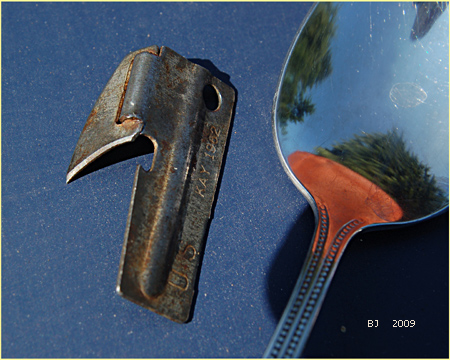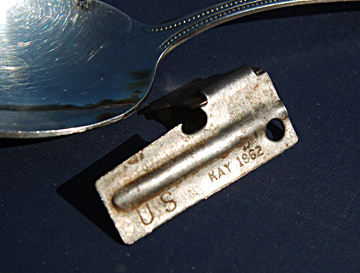 .
. .
.The hot Southern Oregon sun beat down on me that August day of 1965. I was hungry, so hungry I felt eager at the prospect of opening my first-ever box of Army C-rations. Nearby, the forest fire that I was fighting smouldered, but I ignored it as I threw down my Pulaski and ripped through the wrappings around my "ration." Inside, I was confronted with several cans and no way to open them. Then a tiny shiny metal object about an inch long fell out and into the pine needles. My solution was at hand. The perfect can-opener! No gears, no wheels, no electricity, no plastic! Elegant and perfect in its simple mechanical design and execution. Should be in the Smithsonian Museum. These two images display my 1962 vintage GI P-38 can opener, still working perfectly after some 50 years, although a bit the worse for wear. Officially, its instruction sheet called it a P-38, but in the Forest Service it was commonly nicknamed a "Church Key," which harked back to early bottle openers which accessed alcoholic and often-restricted substances such as beer! Invented in 1942 for WW II, some have called it the "Army's Best Invention," famed for its speed of can-opening, and also revered for its multi-tool capabilities, eg. it can be used as a screwdriver, a fingernail cleaner, a dull mini-knife, and much more! I read that the "38" referred to how many punches around the rim were required to open a can of C-rations. See complete story of P-38 below, by Maj Renita Foster.

Sadly, since this device went mass-market, its quality has often gone downhill, and there sometimes isn't so much to admire about the perfection of the device. It seems too simple to mess-up, but I've bought some new ones at mass-market outlets and been disappointed. Perhaps the metal is cheaper and softer, but they just lacked the fine cutting abilities of the original from that old C-ration box, so my stained 1962 opener maintains a prime spot on my mini-biner that goes with me on any and all outdoor excursions!
Please Note: All Material below, and in all my "History
of Gear" webpages, is copyrighted, and no usage of my material
is permitted unless explicit permission is granted by me, Bruce
B. Johnson, owner of OregonPhotos.com. ...... Editors: Please contact
me (brucej@oregonphotos.com) if you have interest in publishing....Others: if you were involved
with one of the old-line, vintage gear companies and have a story
to tell in these pages, please contact me soon.
Author's version, "the Ten+ Essentials" list and discussion.
THE SIX HISTORY OF GEAR BOOKS AND OTHER STORIES (Link here):
Books 1-4 are presented in 8x10 format with choice of hardbound or softbound and all lavishly illustrated with high-quality color images. Books 1-4 can also be ordered directly from me as $15 PDF downloads.... Book 5 is our bargain book, offered in a simple 6x9 inch, black&white format... Book 1: "Frostline of Colorado," updated in 2012 after Dale Johnson, its founder, passed away (Frostline). Book 2: "GERRY, To Live in the Mountains," updated in late 2010 after Mr. Cunningham passed away (GERRY). Book 3: "Holubar Mountaineering, Ltd.," rightly regarded as the inventor of the modern lightweight down sleeping bag, among other honors (Holubar). The Holubar book was lauded in 2012 as one of the year's best "Local History" books at Chautauqua in Boulder, Colorado.... Book 4: "MSR: Defying Tradition, describes Larry Penberthy's often controversial rhetoric as he took on the Climbing Establishment through his Seattle-based Mountain Safety Research company (MSR) (MSR). Book 5: "Warmlite: Still Controversial After All These Years" tells the tale of Stephenson's Warmlite Equipment, with its radically innovative products and boldly notorious nudist founder (Warmlite). All five books feature major contributions from their founders/Presidents or chief personnel. You may order the books directly from my Publisher, and the PDF version directly from me (oldgear@oregonphotos.com).... My book of mountain stories is a short and very personal book about spiritual awakenings in the mountains, set up as a Kindle book through Amazon. I am a verified PayPal seller.
Thanks to MAJ Renita Foster for the following History of the P38
Story by Major Renita Foster
The P38 was developed in just 30 days in the summer of 1942 by
the Subsistence Research Laboratory in Chicago. And never in its
history has it been known to break, rust, need sharpening or polishing.
Perhaps that is why many soldiers, past and present, regard the
P-38 C-ration can opener as the Army's best invention. C-rations
have long since been replaced with the more convenient Meals,
Ready to Eat, but the fame of the P-38 persists, thanks to the
many uses stemming from the unique blend of ingenuity and creativity
all soldiers seem to have. "The P-38 is one of those tools
you keep and never want to get rid of," said Sgt. Scott Kiraly,
a military policeman. "I've had my P-38 since joining the
Army 11 years ago and kept it because I can use it as a screwdriver,
knife, anything." The most vital use of the P-38, however,
is the very mission it was designed for, said Fort Monmouth, N.J.,
garrison commander Col. Paul Baerman. "When we had C-rations,
the P-38 was your access to food; that made it the hierarchy of
needs," Baerman said. "Then soldiers discovered it was
an extremely simple, lightweight, multipurpose tool. I think in
warfare, the simpler something is and the easier access it has,
the more you're going to use it. The P-38 had all of those things
going for it."
The tool acquired its name from the 38 punctures required to open a C-ration can, and from the boast that it performed with the speed of the World War II P-38 fighter plane. "Soldiers just took to the P-38 naturally," said World War II veteran John Bandola. "It was our means for eating 90 percent of the time, but we also used it for cleaning boots and fingernails, as a screwdriver, you name it. We all carried it on our dog tags or key rings." When Bandola attached his first and only P-38 to his key ring a half century ago, it accompanied him to Anzio, Salerno and through northern Italy. It was with him when World War II ended, and it's with him now. "This P-38 is a symbol of my life then," said Bandola. "The Army, the training, my fellow soldiers, all the times we shared during a world war." Sgt. Ted Paquet, swing shift supervisor in the Fort Monmouth Provost Marshal's Office, was a 17-year-old seaman serving aboard the amphibious assault ship USS New Orleans during the Vietnam war when he got his first P-38. The ship's mission was to transport Marines off the coast of Da Nang. On occasional evenings, Marines gathered near Paquet's duty position on the fantail for simple pleasures like "Cokes, cigarettes, conversation and C-rations." It was during one of these nightly sessions that Paquet came in contact with the P-38, or "John Wayne" as it's referred to in the Navy. Paquet still carries his P-38, and he still finds it useful. While driving with his older brother, Paul, their car's carburetor began to have problems.
"There were no tools in the car and, almost
simultaneously, both of us reached for P-38s attached to our key
rings," Paquet said with a grin. "We used my P-38 to
adjust the flow valve, the car worked perfectly, and we went on
our merry way." Paquet"s P-38 is in a special box with
his dog tags, a .50-caliber round from the ship he served on,
his Vietnam Service Medal, South Vietnamese money and a surrender
leaflet from Operation Desert Storm provided by a nephew. "It
will probably be on my dresser until the day I die," Paquet
said. The feelings veterans have for the P-38 aren't hard to understand,
according to 1st Sgt. Steve Wilson of the Chaplain Center and
School at Fort Monmouth. "When you hang on to something for
26 years," he said, "it's very hard to give it up. That's
why people keep their P-38 just like they do their dog tags. ...
It means a lot. It's become part of you. You remember field problems,
jumping at 3 a.m. and moving out. A P-38 has you reliving all
the adventures that came with soldiering in the armed forces.
Yes, the P-38 opened cans, but it did much more. Any soldier will
tell you that."
items since more and more people are putting them in their military
& medal displays or their P-38 collections. P-38 collections
don't cost too much and don't take up much space and they're a
lot of fun finding the hard to get ones. I've had the same P-38
on my key-ring ever since my first Boy Scout camping trip when
my Scoutmaster gave it to me to open the big cans of peaches for
the delicious cobbler he would make over the campfire in a huge
cast iron skillet. I can still taste that delicious cobbler as
we sat around the campfire before crawling into our sleeping bags.
My Scoutmaster was a WWII and Korean War veteran that knew how
handy the little P-38s were and he gave one to every new member
of the Scout troop on their first camping trip. Recently P-38s
have added a new role to their long list of uses. Shelters and
organizations that aid the homeless hand them out and also they
were included in the humanitarian relief packets dropped into
Afghanistan. I've also been told they have been handed out here
in the USA by relief organizations after natural disasters (hurricanes,
tornadoes, storms and floods) for when the power is out and electric
can openers no longer work. A P-38 is a lesson in simplicity at
it's best. taken from surplus yes listing
Don't you
wish everything in life could be as simple and useful as a P-38.
List of P-38 Uses By Steve Wilson, MSG Proponent
NCO, Dept of the Army
Office of the Chief of Chaplains, The Pentagon
1. Can Opener
2. Seam Ripper
3. Screwdriver taken from surplus yes listing
4. Clean Fingernails
5. Cut Fishing Line
6. Open Paint Cans
7. Window Scraper
8. Scrape Around Floor Corners
9. Digging
10. Clean Out Groove on Tupperware lids
11. Reach in and Clean Out Small Cracks
12. Scrape Around Edge of Boots
13. Bottle Opener
14. Gut Fish (in the field)
15. Scale Fish (in the field)
16. Test for 'Doneness' When Baking on a Camp Fire
17. Prying Items taken from surplusyes listing
18. Strip Wire
19. Scrape Pans in the Field
20. Lift Key on Flip Top Cans
21. Chisel
22. Barter
23. Marking Tool
24. Deflating Tires
25. Clean Sole of Boot/Shoe
26. Pick Teeth
27. Measurement
28. Striking Flint
29. Stirring Coffee copied from surplus yes
30. Puncturing Plastic Coating
31. Knocking on Doors
32. Morse Code
33. Box Cutter
34. Opening Letters
35. Write Emergency Messages
36. Scratch an Itch
37. Save as a Souvenir
38. Rip Off Rank for On-the-Spot Promotions